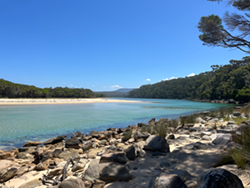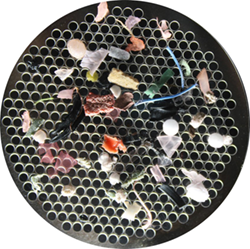Microplastics monitoring
The NSW Government is undertaking a Broadscale Microplastic Assessment (BMA) of 120 estuaries to provide a baseline dataset for surface water microplastic contamination.
The aim of this study is to:
- Highlight estuaries with the highest microplastic contamination levels
- Determine what items are contributing the most to microplastic contamination for NSW.
The NSW Marine Debris Threat and Risk Assessment identified microplastics as a high-priority threat item. Identifying microplastic items such as plastic resin pellets and polystyrene provides critical information to support evidence-based litter prevention programs and the NSW Plastics Action Plan. This gives us a better understanding of the source of microplastics to then prioritise management interventions and reduce the impacts. This data will identify estuaries and catchments to prioritise management efforts and will be used in the future for assessing management effectiveness.
How the research supports programs
The BMA project identifies catchments where plastic feedstock (also known as nurdles) are present and guides other programs such as Operation Clean Sweep NSW (OCS). Data from OCS is used to help identify plastic feedstock sources further upstream to implement interventions for where plastic resin is leaking into the environment.
About the project
The study is undertaken by the Coastal and Marine Science team in the Department of Climate Change, Energy, the Environment and Water (DCCEEW). To fill knowledge gaps around microplastics in NSW, the rapid microplastic assessment method was developed as part of the Marine Estate Management Strategy (MEMS). This method has been adopted for the BMA project, which is funded by the EPA.
The project has 3 major outputs:
- A state-wide baseline microplastic data set – which measures the microplastic density in 120 estuaries.
- Microplastic Pollution Grades – which are developed by comparatively assessing the microplastic density across NSW estuaries and rating them high, medium or low based on the number of microplastics.
- Microplastic identification – using the state-wide data set we are identifying each microplastic polymer type. This will enable government to prioritise those estuaries and microplastic types to be targeted for management and intervention.
A | B | C | D | E | F | G | H | J | K | L | M | N | O | P | R | S | T | U | W
- Avoca Lake
- Batemans Bay
- Bega River
- Bellinger River
- Belongil Creek
- Bermagui River
- Berowra Creek
- Botany Bay
- Brisbane Water
- Broken Bay
- Brunswick River
- Burrill Lake
- Camden Haven River
- Cararma Creek
- Cathie Creek
- Clarence River
- Clyde River
- Cockrone Lake
- Coffs Creek
- Coila Lake
- Congo Creek
- Conjola Lake
- Cooks River
- Coolongolook River
- Corindi River
- Corunna Lake
- Cowan Creek
- Crooked River
- Cudgen Creek
- Currambene Creek
- Darkum Creek
- Dee Why Lagoon
- Duck River
- Durras Lake
- Evans River
- Fairy Creek
- Flat Top Point Creek
- Georges River
- Glenrock Lagoon
- Haslams Creek
- Hastings River
- Hawkesbury River Lower
- Hawkesbury River Upper
- Hearns Lake
- Hunter River
- Jervis Bay
- Karuah River
- Khappinghat Creek
- Lake Ainsworth
- Lake Arragagn
- Lake Illawarra
- Lake Macquarie (North)
- Lake Macquarie (South)
- Lake Mummuga
- Lane Cove River
- Macleay River
- Manly Lagoon
- Manning River Lower
- Manning River Upper
- Maria River
- Merimbula Lake
- Meringo Creek
- Merrica River
- Middle Harbour
- Middle lagoon
- Minnamurra River
- Moona Moona Creek
- Moonee Creek
- Moruya River
- Muddy Creek
- Myall Broadwater
- Myall Lake
- Myall River
- Nadgee Lake
- Nadgee River
- Nambucca River
- Narrabeen Lagoon
- North Creek
- Nullica River
- Oyster Channel
- Pambula River
- Parramatta River
- Pipers Creek (Wallis Lake)
- Pittwater
- Port Hacking
- Port Jackson
- Port Stephens
- Richmond River
- Saltwater Creek (Frederickton)
- Sandon River
- Shoalhaven River
- Smiths Lake
- South West Rocks Creek
- St Georges Basin
- Station Creek
- Swan Lake
- Tallow Creek
- Terranora Creek
- Terrigal Lagoon
- Throsby Creek
- Tilba Tilba Lake
- Tilligery
- Tomaga River
- Toongabbie Creek
- Towamba River
- Towradgi Creek
- Tuggerah Lake
- Tuggerah Lakes/Budgewoi Lake
- Tuggerah Lakes/Lake Munmorah
- Tuross River
- Tweed River
- Twofold Bay
- Ulladulla
- Wagonga Inlet
- Wallaga Lake
- Wallagoot Lake
- Wallamba Cove
- Wallamba River
- Wallis Lake
- Wamberal Lagoon
- Wapengo Lagoon
- Wattamolla Creek
- Werri Lagoon
- Wonboyn River
- Woolgoola Lake
- Wooli River

